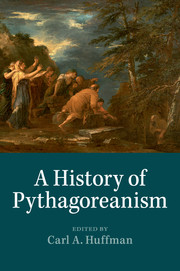Crossref Citations
This Book has been
cited by the following publications. This list is generated based on data provided by Crossref.
Kanavou, Nikoletta
2018.
Philostratros’ Life of Apollonios of Tyana and its Literary Context.
p.
246.
Hladký, Vojtěch
2018.
Transmigrating Soul Between the Presocratics and Plato.
Aither,
Vol. 10,
Issue. 20,
p.
20.
Bryan, Jenny
Wardy, Robert
and
Warren, James
2018.
Authors and Authorities in Ancient Philosophy.
Rosella Schluderer, Laura
2018.
IMITATING THE COSMOS: THE ROLE OF MICROCOSM–MACROCOSM RELATIONSHIPS IN THE HIPPOCRATIC TREATISEON REGIMEN.
The Classical Quarterly,
Vol. 68,
Issue. 1,
p.
31.
Zhmud, Leonid
2019.
What is Pythagorean in the Pseudo-Pythagorean Literature?.
Philologus,
Vol. 163,
Issue. 1,
p.
72.
Horky, Phillip Sidney
2019.
Cosmos in the Ancient World.
Klavan, Spencer A.
2019.
SUNG POEMS AND POETIC SONGS: HELLENISTIC DEFINITIONS OF POETRY, MUSIC AND THE SPACES IN BETWEEN.
The Classical Quarterly,
Vol. 69,
Issue. 2,
p.
597.
Santacroce, Luigi
Charitos, Ioannis Alexandros
Topi, Skender
and
Bottalico, Lucrezia
2019.
The Alcmaeon’s School of Croton: Philosophy and Science.
Open Access Macedonian Journal of Medical Sciences,
Vol. 7,
Issue. 3,
p.
500.
Huffman, Carl A.
2019.
Aristoxenus of Tarentum: <I>The Pythagorean Precepts (How to Live a Pythagorean Life)</I>.
Freidin, Anna Bonnell
2020.
The Birthday Present: Censorinus’De die natali.
Journal of Roman Studies,
Vol. 110,
Issue. ,
p.
141.
Pelosi, Francesco
and
Petrucci, Federico M.
2020.
Music and Philosophy in the Roman Empire.
Weber‑Pallez, Clémence
2020.
Le bouclier d’Argos à travers le temps : diachronie d’un symbole politique.
Bulletin de Correspondance Hellénique,
Raffa, Massimo
2020.
A Companion to Ancient Greek and Roman Music.
p.
311.
Taub, Liba
2020.
The Cambridge Companion to Ancient Greek and Roman Science.
Roskam, Geert
2020.
SOME FRESH AIR INTO THE NEOPYTHAGOREAN TRADITION: THE FRAGMENTS FROMON KINGSHIPBY DIOTOGENES.
The Cambridge Classical Journal,
Vol. 66,
Issue. ,
p.
203.
2021.
The Herodotus Encyclopedia.
p.
1031.
Payne, Andrew
2021.
Definition and Inquiry in Archytas.
Ancient Philosophy Today,
Vol. 3,
Issue. 1,
p.
98.
Horky, Phillip Sidney
2021.
Immortality in Ancient Philosophy.
p.
41.
Trépanier, Simon
2021.
Immortality in Ancient Philosophy.
p.
12.
De Pisapia, Nicola
and
Dall’Avanzi, Martina
2022.
The Examination of Conscience: A Preliminary Study on the Effects on Metamemory After a 2-Week Practice.
Frontiers in Psychology,
Vol. 13,
Issue. ,



